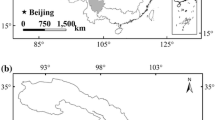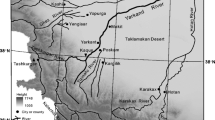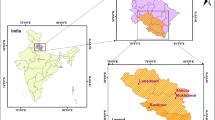Abstract
A wavelet network model is developed to predict the inflow of Three Gorges dam in Yangtze River, China. The model makes use of the multi-resolution analysis of wavelet analysis and the nonlinear capability of artificial neural network. The short and long term input runoff of Three Gorges dam, such as annual mean discharge, seasonal mean discharge of 10 days period, daily mean discharge and annual maximum flood peak discharge, have been predicted with the wavelet network model (WNM). At the same time a kind of threshold auto-regressive model (TAR) has also applied for those predictions. The comparison of WNM with TAR has been executed. The results show that the accuracy of model predictions with WNM is generally better than that with TAR. The suggested wavelet network model is functional and feasible for runoff prediction.
Similar content being viewed by others
References
Anctil F, Coulibaly P (2004) Wavelet analysis of the inter-annual variability in southern Quebec stream flow. J Clim 17:163–173. doi:10.1175/1520-0442(2004)017<0163:WAOTIV>2.0.CO;2
Aussem A, Campbell J, Murfagh F (1998) Wavelet-based feature extraction and decomposition strategies for financial forecasting. J Comput Intell Finance 6:1–17
Bayazit M, Aksoy H (2001) Using wavelets for data generation. J Appl Stat 28(2):157–166. doi:10.1080/02664760020016073
Bowden GJ, Maier HR, Dandy GC (2002) Optimal division of data for neural network models in water resources applications. Water Resour Res 38(2):1–11. doi:10.1029/2001WR000266
Box GH, Jenkins G (1970) Time series analysis: forecasting and control. Holden-Day, San Francisco
Chen SY (2005) Theories and methods of variable fuzzy sets in water resources and flood control system. Dalian University of Technology Press, Dalian
Chou CM (2007) Applying multi-resolution analysis to differential hydrological grey models with dual series. J Hydrol (Amst) 332:174–186. doi:10.1016/j.jhydrol.2006.06.031
Chui CK (1995) Wavelet—a tutorial in theory and applications. Xi’an Jiao Tong University Press, Xi’an
Deng JL (1992) Grey prediction and grey decision. Hua Zhong Li Gong University Press, Wuhan
Ding J, Deng YR (1988) Stochastic hydrology. Chengdu University of Science and Technology Press, Chengdu
El-Shafie A, Taha MR, Noureldin A (2007) A neuro-fuzzy model for inflow forecasting of the Nile river at Aswan high dam. Water Resour Manage 21:533–556. doi:10.1007/s11269-006-9027-1
French MN, Krajewski WF, Cuykendall RR (1992) Rainfall forecasting in space and time using a neural network. J Hydrol (Amst) 137:1–31. doi:10.1016/0022-1694(92)90046-X
Half AH, Halff HM, Azmoodeh M (1993) Predicting runoff from rainfall using artificial neural networks. Proc Engng Hydrol ASCE 761–765
Hua B, Xiong W, Cheng H (2008) Application of fuzzy support vector machine to runoff forecast. Eng J Wuhan Univ 41(1):5–8
Huang WR, Catherine M (2008) Multiple-station neural network for modeling tidal currents across Shinnecock Inlet, USA. Hydrol Process 22:1136–1149. doi:10.1002/hyp.6671
Jayawardena AW, Lai F (1994) Analysis and prediction of chaos in rainfall and streamflow time series. J Hydrol (Amst) 153:23–52. doi:10.1016/0022-1694(94)90185-6
Jin JL, Ding J (2002) Water resource systems engineering. Sichuan Science and Technology Press, Sichuan
Karunasinghe DSK, Liong SY (2006) Chaotic time series prediction with a global model: artificial neural network. J Hydrol 153:23–52, 323:92–105
Kisi O (2007) Streamflow forecasting using different artificial neural network algorithms. J Hydrol Eng 12(5):532–539. doi:10.1061/(ASCE)1084-0699(2007)12:5(532)
Kisi O (2008a) Stream flow forecasting using neuro-wavelet technique. Hydrol Process 22(20):4142–4152. doi:10.1002/hyp.7014
Kisi O (2008b) River flow forecasting and estimation using different artificial neural network techniques. Hydrol Res 39(1):27–40. doi:10.2166/nh.2008.026
Kisi O, Cigizoglu HK (2007) Comparison of different ANN techniques in river flow prediction. Civ Eng Environ Syst 24(3):211–231. doi:10.1080/10286600600888565
Kumar P, Georgiou EF (1993) A multicomponent decomposition of spatial rainfall fields 1. Segregation of large- and small-scale features using wavelet transforms. Water Resour Res 29(8):2515–2532. doi:10.1029/93WR00548
Labat D, Ababou R, Mangin A (2000) Rainfall–runoff relations for karstic springs Part II: continuous wavelet and discrete orthogonal multi-resolution analyses. J Hydrol (Amst) 238:149–187. doi:10.1016/S0022-1694(00)00322-X
Li XB, Ding J, Li HQ (1999) Combing neural network models based on wavelet transform. J Hydraul 2:1–4
Mallat SG (1989) Multifrequency channel decomposition of images and wavelet models. IEEE Trans ASSP 37(12):2091–2110
Partal T, Kisi O (2007) Wavelet and neuro-fuzzy conjunction model for precipitation forecasting. J Hydrol (Amst) 342(1–2):199–212. doi:10.1016/j.jhydrol.2007.05.026
Qing GH, Ding J, Liu GD (2002) Self-adapted BP algorithm and its application to flood forecast of river. Advance Water Sci 13(1):37–41
Raman H, Sunilkumar N (1995) Multivariate modeling of water resource time series using artificial neural network. Hydrol Sci J 40(21):145–163
Shensa MJ (1992) Discrete wavelet transform: wedding the A Trous and Mallat algorithm. IEEE Trans Signal Process 40:2464–2482. doi:10.1109/78.157290
Smith LC, Turcotte DL, Sacke BI (1998) Stream flow characterization and feature detection using a discrete wavelet transform. Hydrol Process 12:233–249. doi:10.1002/(SICI)1099-199802)12:2<233::AID-HYP573>3.0.CO;2-3
Tesong H, Lam KC, Ng ST (2001) River flow time series prediction with a range dependent neural network. Hydrol Sci J 46(5):729–745
Tokar AS, Johnson PA (1999) Rain–runoff modeling using artificial neural network. J Hydrol Engng ASCE 4(3):232–239. doi:10.1061/(ASCE)1084-0699(1999)4:3(232)
Tong H (1990) Non-linear time series: a dynamical system approach. Oxford university press, Oxford
Wang WS, Ding J (2003a) Study on periodicity and long term forecast of annual maximum peak discharge at Yichang station of Yangtze River. J Sichuan Univ 35(1):20–23
Wang WS, Ding J (2003b) Wavelet network model and its application to the prediction of hydrology. Nature and Science 1(1):63–67
Wang WS, Ding J, Li YQ (2005) Hydrology wavelet analysis. Chemical Industry Press, Beijing
Wang HF, Huang WJ, Wang WS et al (2006a) Cuntan station of the Yangtze River annual runoff forecasting with set pair analysis method. J Heilongjiang Hydraul Eng Coll 33(4):3–5
Wang W, Pieter HAJM, Van Gelder JK et al (2006b) Forecasting daily streamflow using hybrid ANN models. J Hydrol (Amst) 324:383–399. doi:10.1016/j.jhydrol.2005.09.032
Wang WS, Xiang HL, Ding J (2001) Predication of hydrology and water resources with nearest neighbor bootstrapping regressive model. Water Resources and Power 19(2):8–10, 14
Zhao KQ (2000) Set pair analysis and its elementary application. Zhejiang Science and Technology Press, Hangzhou
Zhang LM (1994) Artificial neural network and its application. Fudan University Press, Shanghai
Author information
Authors and Affiliations
Corresponding author
Rights and permissions
About this article
Cite this article
Wang, W., Jin, J. & Li, Y. Prediction of Inflow at Three Gorges Dam in Yangtze River with Wavelet Network Model. Water Resour Manage 23, 2791–2803 (2009). https://doi.org/10.1007/s11269-009-9409-2
Received:
Accepted:
Published:
Issue Date:
DOI: https://doi.org/10.1007/s11269-009-9409-2




